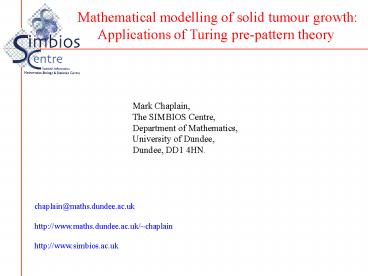tumour rd pattern formation PowerPoint PPT Presentation
1 / 51
Title: tumour rd pattern formation
1
Mathematical modelling of solid tumour
growth Applications of Turing pre-pattern theory
Mark Chaplain, The SIMBIOS Centre, Department of
Mathematics, University of Dundee, Dundee, DD1
4HN.
chaplain_at_maths.dundee.ac.uk http//www.maths.dund
ee.ac.uk/chaplain http//www.simbios.ac.uk
2
Talk Overview
- Biological (pathological) background
- Avascular tumour growth
- Invasive tumour growth
- Reaction-diffusion pre-pattern models
- Growing domains
- Conclusions
3
The Individual Cancer Cell A Nonlinear Dynamical
System
4
The Multicellular Spheroid Avascular Growth
- 10 6 cells
- maximum diameter 2mm
- Necrotic core
- Quiescent region
- Thin proliferating rim
5
Malignant tumours CANCER
Generic name for a malignant epithelial (solid)
tumour is a CARCINOMA (Greek Karkinos, a crab).
Irregular, jagged shape often assumed due to
local spread of carcinoma.
Basement membrane
Cancer cells break through basement membrane
6
Turing pre-pattern theory Reaction-diffusion
models
7
Turing pre-pattern theory Reaction-diffusion
models
Two morphogens u,v Growth promoting factor
(activator) Growth inhibiting factor (inhibitor)
Consider the spatially homogeneous steady state
(u0 , v0 ) i.e.
We require this steady state to be (linearly)
stable (certain conditions on the Jacobian matrix)
8
Turing pre-pattern theory Reaction-diffusion
models
We consider small perturbations about this steady
state
it can be shown that.
9
Turing pre-pattern theory Reaction-diffusion
models
...we can destabilise the system and evolve to a
new spatially heterogeneous stable steady state
(diffusion-driven instability) provided that
where
DISPERSION RELATION
10
Dispersion curve
Re ?
k2
11
Mode selection dispersion curve
Re ?
k2
12
Turing pre-pattern theory.
- robustness of patterns a potential problem
(e.g. animal coat marking) - (lack of) identification of morphogens
???
1) Crampin, Maini et al. - growing domains
Madzvamuse, Sekimura, Maini - butterfly wing
patterns
2) limited number of morphogens found de
Kepper et al
13
Turing pre-pattern theory RD equations on the
surface of a sphere
Growth promoting factor (activator) u Growth
inhibiting factor (inhibitor) v Produced, react,
diffuse on surface of a tumour spheroid
14
Numerical analysis technique
Spectral method of lines
Apply Galerkin method to system of
reaction-diffusion equations (PDEs) and then end
up with a system of ODEs to solve for (unknown)
coefficients
15
Galerkin Method
16
Numerical Quadrature
17
Collaborators
- M.A.J. Chaplain, M. Ganesh, I.G. Graham
- Spatio-temporal pattern formation on spherical
surfaces numerical - simulation and application to solid tumour
growth. - J. Math. Biol. (2001) 42, 387- 423.
- Spectral method of lines, numerical quadrature,
FFT - reduction from O(N 4) to O(N 3 logN) operations
18
Numerical experiments on Schnackenberg system
19
Mode selection n2
20
Chemical pre-patterns on the sphere
mode n2
21
Mode selection n4
22
Chemical pre-patterns on the sphere
mode n4
23
Mode selection n6
24
Chemical pre-patterns on the sphere
mode n6
25
Solid Tumours
- Avascular solid tumours are small spherical
masses of cancer cells - Observed cellular heterogeneity (mitotic
activity) on the surface and in - interior (multiple necrotic cores)
- Cancer cells secrete both growth inhibitory
chemicals and growth - activating chemicals in an autocrine manner-
- TGF-ß (-ve)
- EGF, TGF-a, bFGF, PDGF, IGF, IL-1a, G-CSF
(ve) - TNF-a (/-)
- Experimentally observed interaction (ve, -ve
feedback) between - several of the growth factors in many different
types of cancer
26
Biological model hypotheses
- radially symmetric solid tumour, radius r R
- thin layer of live, proliferating cells
surrounding a necrotic core - live cells produce and secrete growth factors
(inhibitory/activating) - which react and diffuse on surface of solid
spherical tumour - growth factors set up a spatially heterogeneous
pre-pattern - (chemical diffusion time-scale much faster than
tumour growth time scale) - local hot spots of growth activating and
growth inhibiting chemicals - live cells on tumour surface respond
proliferatively (/) to distribution of - growth factors
27
The Individual Cancer Cell
28
29
Multiple mode selection No isolated mode
30
Chemical pre-pattern on sphere no specific
selected mode
31
Invasion patterns arising from chemical
pre-pattern
32
Growing domain Moving boundary formulation
R(t) 1 at
33
Mode selection in a growing domain
t 15
t 9
t 21
34
Chemical pre-pattern on a growing sphere
35
1D growing domain Boundary growth
Growth occurs at the end or edge or boundary of
domain only
Growth occurs at all points in domain
uniform domain growth
36
G. Lolas Spatio-temporal pattern formation and
reaction-diffusion equations. (1999) MSc Thesis,
Department of Mathematics, University of Dundee.
37
1D growing domain Boundary growth
38
1D growing domain Boundary growth
39
Dispersion curve
Re ?
k2
20
90
40
Spatial wavenumber spacing
n k2 n(n1) k2 n2 p2 (sphere) (1D) 2
6 40 3 12
90 4 20
160 5 30
250 6 42
360 7 56
490 8 72
640 9 90
810 10 110
1000
41
2D growing domain Boundary growth
42
2D growing domain Boundary growth
43
2D growing domain Boundary growth
44
2D growing domain Boundary growth
45
46
Cell migratory response to soluble molecules
CHEMOTAXIS
47
Cell migratory response to local tissue
environment cues HAPTOTAXIS
48
The Individual Cancer Cell A Nonlinear Dynamical
System
49
Tumour Cell Invasion of Tissue
- Tumour cells produce and secrete
Matrix-Degrading-Enzymes - MDEs degrade the ECM creating gradients in the
matrix - Tumour cells migrate via haptotaxis (migration
up gradients - of bound - i.e. insoluble - molecules)
- Tissue responds by secreting MDE-inhibitors
50
Conclusions
- Identification of a number of genuine autocrine
growth factors - practical application of Turing pre-pattern
theory (50 years on.!) - heterogeneous cell proliferation pattern linked
to underlying - growth-factor pre-pattern irregular
invasion of tissue - robustness is not a problem each patient has
a different cancer - growing domain formulation
- clinical implication for regulation of local
tissue invasion via - growth-factor concentration level manipulation
51
Summary

